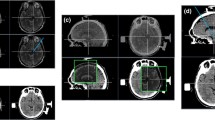Abstract
Background
Deep brain stimulation (DBS) surgery utilizes image guidance via bone-implanted fiducial markers to achieve the desired submillimetric accuracy and to provide means for attaching microstereotactic frames. For maximal benefit, the markers must be inserted to the correct depth since over-insertion leads to stripping and under-insertion leads to instability.
Purpose
The purpose of the study was to test clinically a depth-release drive system, the PosiSeat\(^{\mathrm{TM}}\), versus manual insertion (pilot hole followed by manual screwing until tactile determined correct seating) for implanting fiducial markers into the bone.
Methods
With institutional review board approval, the PosiSeat\(^{\mathrm{TM}}\) was used to implant markers in 15 DBS patients (57 fiducials). On post-insertion CT scans, the depth of the gap between the shoulder of the fiducial markers and the closest bone surface was measured. Similar depth measurements were performed on the CT scans of 64 DBS patients (250 fiducials), who underwent manual fiducial insertion.
Results
Median of shoulder-to-bone distance for PosiSeat\(^{\mathrm{TM}}\) and manual insertion group were 0.03 and 1.06 mm, respectively. Fifty percent of the fiducials had the shoulder-to-bone distances within 0.01–0.09 mm range for the PosiSeat group and 0.04–1.45 mm range for the manual insertion group. These differences were statistically significant.
Conclusions
A depth-release drive system achieves more consistent placement of bone-implanted fiducial markers than manual insertion.




Similar content being viewed by others
References
Benabid L, Vercucil L, Benazzouz A, Koudsie A, Chabardes S, Minotti L, Kahane P, Gentil M, Lenartz D, Andressen C, Krack P, Pollak P (2003) Deep brain stimulation: what does it offer? Adv Neurol 91:293–302
Deuschl G, Wenzelburger R, Kopper F, Volkmann J (2003) Deep brain stimulation of the subthalamic nucleus for Parkinson’s disease: A therapy approaching evidence-based standards. J Neurol 250(1):143–146
Fitzpatrick JM (2010) The role of registration in accurate surgical guidance. J Eng Med 224(5):607–622
Henderson JM (2004) Frameless localization for functional neurosurgical procedures. Stereotact Funct Neurosurg 82:135–141. doi:10.1159/000081345
Konrad PE, Neimat JS, Yu H, Kao CC, Remple MS, D’Haese PF, Dawant BM (2011) Customized, miniature rapid-prototype stereotactic frames for use in deep brain stimulator surgery: initial clinical methodology and experience from 263 patients from 2002 to 2008 study. Stereotact Funct Neurosurg 89(1):34–41
Balachandran R, Mitchell JE, Dawant BM (2009) Accuracy evaluation of microtargeting platforms for deep-brain stimulation using virtual targets. IEEE Trans Biomed Eng 56(1):37–44
Maciunas RJ, Galloway RL Jr, Latimer J, Cobb C, Zaccharias E, Moore A, Mandava VR (1992) An independent application accuracy evaluation of stereotactic frame systems. Stereotact Funct Neurosurg 58(1–4):103–107
Maciunas RJ, Galloway Jr RL, Latimer JW (1994) The application accuracy of stereotactic frames. Neurosurgery 35(4):682–694. (discussion 694–695)
Yu C, Apuzzo ML, Zee CS, Petrovich Z (2001) A phantom study of the geometric accuracy of computed tomographic and magnetic resonance imaging stereotactic localization with the Leksell stereotactic system. Neurosurgery 48(5):1092–1098. (discussion 1098–1099)
Bjartmarz H, Rehncrona S (2007) Comparison of accuracy and precision between frame-based and frameless stereotactic navigation for deep brain stimulation electrode implantation. Stereotact Funct Neurosurg 85(5):235–242
Henderson JM, Holloway KL, Gaede SE, Rosenow JM (2004) The application accuracy of a skull-mounted trajectory guide system for image-guided functional neurosurgery. Comput Aided Surg 9(4):155–160
Aziz TZ, Nandi D, Parkin S, Liu X, Giladi N, Bain P, Gregory RG, Joint C, Scott RB, Stein JF (2001) Targeting the subthalamic nucleus. Stereotact Funct Neurosurg 77:87–90
Galloway RL, Maciunas RJ (1990) Stereotactic neurosurgery. Crit Rev Biomed Eng 18:181–205
Mitchell J, Labadie RF, Fitzpatrick JM (2010) Design of a novel device to provide assured seating of bone implanted fiducial markers. J Med Devices 4(2):025002–4
Liu X, Cevikalp H, Fitzpatrick JM (2003) Marker orientation in fiducial registration. In: Proceedings SPIE Medical Imaging 2003, San Diego, CA, vol 5032. pp 1176–1185
Kobler JP, Díaz J, Fitzpatrick JM, Lexow GJ, Majdani O, Ortmaier T (in press) Localization accuracy of sphere fiducials in computed tomography images. SPIE Medical Imaging 2014, San Diego, CA
Acknowledgments
The project described was supported by Award Numbers R01DC008408 from the National Institute on Deafness and Other Communication Disorders. The content is solely the responsibility of the authors and does not necessarily represent the official views of the National Institute on Deafness and Other Communication Disorders or the National Institutes of Health. Human subjects participation statements All procedures followed were in accordance with the ethical standards of the responsible committee on human experimentation (institutional and national) and with the Helsinki Declaration of 1975, as revised in 2008 (5). Informed consent was obtained from all patients for being included in the study.
Conflict of interest
Balachandran, Fritz, Dietrich, Danilchenko, Oldfield, Lipscomb, Neimat, Konrad: No conflict of interest. Mitchell, Fitzpatrick, Labadie: Invented the insertion device that has been licensed to a commercial entity. No payment has been received nor is expected to be received due to the small clinical volume and non-disposable nature of the tool. The licensing agreement is in place to make the device available, from an FDA regulatory standpoint, for routine clinical use.
Author information
Authors and Affiliations
Corresponding author
Rights and permissions
About this article
Cite this article
Balachandran, R., Fritz, M.A., Dietrich, M.S. et al. Clinical testing of an alternate method of inserting bone-implanted fiducial markers. Int J CARS 9, 913–920 (2014). https://doi.org/10.1007/s11548-014-0980-5
Received:
Accepted:
Published:
Issue Date:
DOI: https://doi.org/10.1007/s11548-014-0980-5




